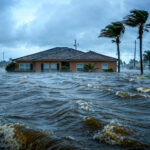The Great New England Hurricane of 1938 would cost insurers $35 billion if it happened today, according to a report released by catastrophe risk experts Karen Clark & Co. (KCC) on the 75th anniversary of the disaster.
Considered by many to be the greatest single event in the meteorological history of the region, the hurricane made landfall near Bellport, Long Island on Sept. 21, 1938. Believed to be a Category 3 on the Saffir-Simpson scale with sustained winds of 120 mph, the storm caused significant wind damage throughout the region, and many coastal towns were completely wiped out by storm surge heights that exceeded 10 feet in many areas.
Forecasters at the time believed hurricanes never hit the Northeast, and no warnings were issued. As a result, nearly 700 people were killed and an equal number injured. Thousands of homes and other buildings were destroyed, 63,000 people were left homeless, and 3,000 ships were sunk or damaged. The hurricane felled millions of trees, downed power lines and caused outages throughout New England.
The KCC report estimates that were the 1938 storm to occur today, insured losses would be about $35 billion—and a similar storm that tracked further to the west would result in insured losses exceeding $100 billion.
 “In the Northeast, it’s not a question of the intensity but of the storm track. It will only take a Category 3 hurricane with the right track to cause industry losses far exceeding anything we’ve seen to date,” says Karen Clark.
“In the Northeast, it’s not a question of the intensity but of the storm track. It will only take a Category 3 hurricane with the right track to cause industry losses far exceeding anything we’ve seen to date,” says Karen Clark.When this type of storm occurs again, the insured damages and economic losses could be larger than any storm seen to date because of the enormous concentrations of property values along the coasts of New York, Connecticut, Rhode Island and Massachusetts. KCC estimates that more than $15 trillion of property value would be in the storm’s footprint today.
“In the Northeast, it’s not a question of the intensity but of the storm track,” says Karen Clark, president and CEO of KCC. “It will only take a Category 3 hurricane with the right track to cause industry losses far exceeding anything we’ve seen to date. This type of storm could also result in losses well above many insurers’ [probable maximum losses].”
The 100-Year Event
The KCC report notes that according to historical records, several major hurricanes impacted the Northeast before 1900. It’s therefore reasonable to assume the 1938 storm is a 100-year type event for the region and has an estimated 1 percent annual probability of occurring.
Such a storm could make landfall anywhere along the Long Island, Rhode Island or Massachusetts coastlines. Each of the different landfall points would result in dramatically different industry losses and damages because hurricanes are “right handed” in the northern hemisphere, with the strongest winds occurring from a few miles to 50 miles to the right of the storm center. Hurricanes that make landfall further to the west will cause greater damage because more of the right side of the storm will be over highly populated areas.
To account for the risk along the entire coastline, KCC developed the Characteristic Event (CE) methodology of “floating” the 100-year storms along the coast and estimating the resulting losses. Spaced at 10-mile increments, there are 22 landfall points from western Long Island to Nantucket. To estimate the losses for the floated CEs, KCC utilized a detailed proprietary database of property values. The CE methodology shows that 100-year storms coming ashore along the western end of Long Island would result in insured losses exceeding $100 billion.
“Historically, no major hurricane has tracked this far to the west, but weaker storms have, such as Irene in 1999,” says Clark. “Tools that rely on the historical record alone can significantly underestimate the chances of this type of an event and potential Northeast hurricane losses. Insurers shouldn’t assume, as the forecasters did in 1938, that a major storm will not follow a particular path simply because there is no record of such an occurrence.”
Source: Karen Clark & Co.




















 EPA Approves California Plan to Ban Gas-Only Cars Starting in 2035
EPA Approves California Plan to Ban Gas-Only Cars Starting in 2035  Odometer Fraud May Exist in More Than 2M Cars on U.S. Roads
Odometer Fraud May Exist in More Than 2M Cars on U.S. Roads  Four P/C Insurers Are ‘AI Titans’; AI Impact Leaders Revealed: Research
Four P/C Insurers Are ‘AI Titans’; AI Impact Leaders Revealed: Research  Moody’s: Rising Flood Risks Posing Greater Challenges for Eastern and Southern U.S.
Moody’s: Rising Flood Risks Posing Greater Challenges for Eastern and Southern U.S. 
